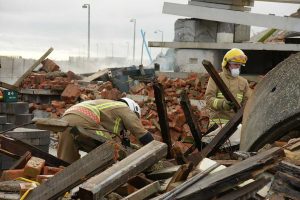Lightning is a fascinating and powerful force of nature that can have devastating consequences. Thunderstorms with lightning strikes can pose a significant risk to people and buildings, making it important to understand how lightning works and what can be done to reduce the risk of damage or injury.
How Lightning Works
Lightning is a natural electrical discharge that occurs when there is a difference in electrical charge between two areas in the atmosphere. This difference in charge can be caused by a variety of factors, including the friction of air molecules, rising warm air, or other atmospheric conditions. When the difference in charge becomes large enough, lightning is triggered, and a bolt of electricity travels from the negatively charged area to the positively charged area. Lightning can travel from cloud to cloud, from cloud to ground, or from ground to cloud.
The Power of Lightning Strikes
A lightning strike can carry millions of volts of electricity and heat the air to over 30,000 degrees Fahrenheit, making it one of the most powerful natural phenomena. When lightning strikes a building, it can cause damage to the steel structure and its electrical systems, as well as start fires or cause explosions. In addition to the physical damage caused by the strike, lightning can also pose a risk to people who are in the area, as the electricity can travel through the ground and cause injury or death.
Are Metal Buildings More Dangerous During Thunderstorms?
There is a common misconception that metal buildings are more dangerous during thunderstorms with lightning strikes than other types of buildings. This is because metal is a good conductor of electricity, and it is believed that lightning is attracted to metal structures. However, this is a myth. Lightning is attracted to the path of least resistance, which is usually the tallest object in the area. Therefore, a tall wooden building is more likely to be struck by lightning than a short metal one.
It is important to note that the consequences of a lightning strike can vary depending on the building’s construction materials. Buildings made with better conductors of electricity, such as metal or copper, are less likely to experience electrical fires or explosions if they are struck by lightning. This is because the electricity can pass through the conductive material more easily, reducing the risk of damage to the building’s electrical systems.
Reducing the Risk of Lightning Strikes
While it is impossible to completely eliminate the risk of lightning strikes, there are steps that can be taken to reduce the risk of damage or injury:
- Stay indoors during thunderstorms, and avoid using electronic devices or plumbing fixtures until the storm has passed.
- If you are outside during a thunderstorm, avoid standing near tall objects such as trees or metal poles.
- If you are inside a building during a thunderstorm, avoid contact with conductive surfaces such as plumbing pipes, electrical wires, or metal objects.
- Install lightning protection systems on buildings that are at high risk of being struck by lightning. These systems include lightning rods, conductive cables, and grounding systems that can redirect the electrical current away from the building.
Final Thoughts
Lightning is a powerful force of nature that can have devastating consequences. While metal buildings are not more dangerous during thunderstorms, it is important to understand how lightning works and what can be done to reduce the risk of damage or injury. By taking the necessary precautions and installing lightning protection systems, it is possible to reduce the risk of lightning strikes and protect people and property from the power of this natural phenomenon.




